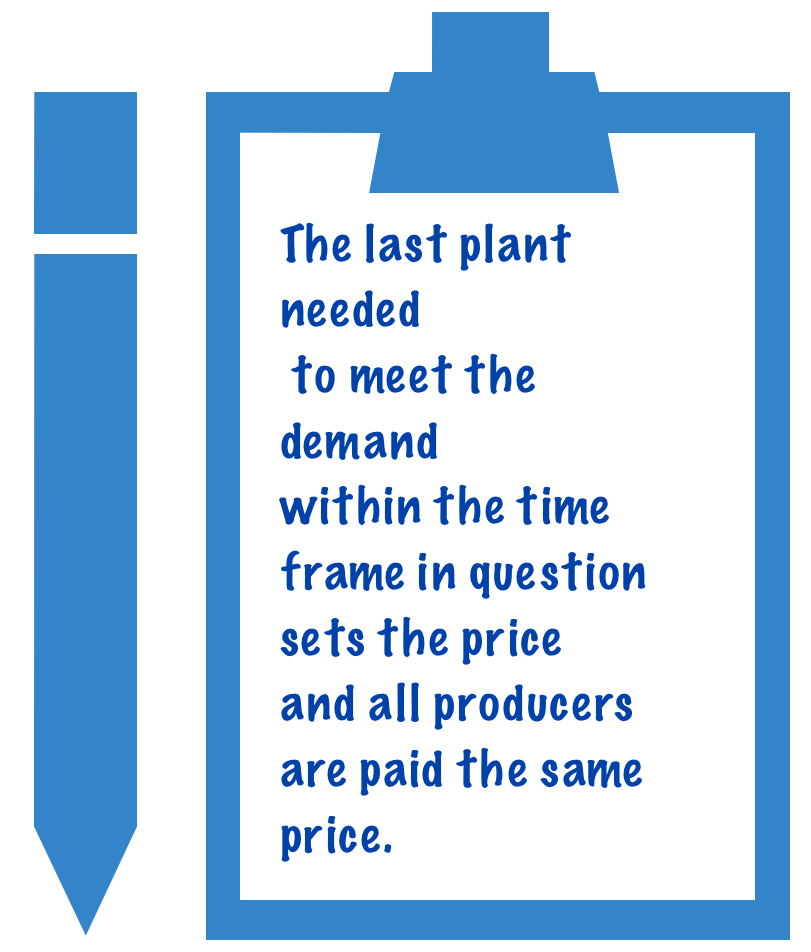Marginal pricing method (also known as a ‘pay-as-clear’ market), the EU electricity market is based on (more specifically, in the day-ahead auction and balancing energy markets), means that everybody receives the same price for electricity at wholesale level. The key feature of this method is that the price is set by the marginal cost (i.e. the cost of producing one more MWh of electricity). Producers are put on the market in merit order starting with the least costly up to the most expensive power plant.

The last plant needed to meet the demand within the time frame in question sets the price and all producers are paid the same price (provided their bid comes under the final clearing price). All electricity producers (including renewables, demand-side response and technologies such as storage) in the same market area (bidding zone) are incentivised to bid their true costs in order to be in the merit order and get dispatched (this is in contrast to speculative bidding of the likely final price outcome). Hence, electricity producers are dispatched the maximum amount of time and are all paid the same price for their electricity, provided their bid comes under the final clearing price.
The above rules have been reflected expressis verbis in Recital 22 of the Proposal of 29 September of 2022 for a Council Regulation on an emergency intervention to address high energy prices (2022/0289 (NLE)), which reads:
“In the day-ahead wholesale market, the least expensive power plants are dispatched first but the price received by all market participants is set by the last plant needed to cover the demand, i.e., that with the highest marginal costs, when the market clears”.
The European Agency ACER in its document “Preliminary Assessment of Europe's high energy prices and the current wholesale electricity market design” of November 2021 included the detailed reasoning supporting the establishment of the marginal pricing in European electricity markets (p. 11). According to the ACER, given that in the EU electricity market prices and trades of electricity are determined through a coordinated process to set prices known as ‘market coupling’, for technologies with higher capital costs and lower operational costs (high-CAPEX, low-OPEX), the 'pay-as-clear' model enables recuperation of their higher capital costs. In the absence of this, such investments would likely not be financially viable. Here, a key feature of the current market design is that it is technology neutral and treats all electricity the same (whether it is from fossil fuels or renewables or ‘offerings’ via reduced demand) the current market design incentivises and facilitates emerging technologies and business models that can smooth volatility (e.g. demand side response, large or small-scale storage, energy communities or a combination through aggregation). Were it not for higher prices that needed ‘smoothing’, such innovative offerings might not emerge. ACER concludes that “these features of the current market design do not in and of themselves prove that the framework is fully future-proof. As such, certain issues may well warrant further attention”.
Also EFET in its document "EFET Insight into Marginal Pricing in Wholesale Electricity Markets" underlines the fact that marginal pricing in the wholesale electricity market allows operators of electricity generation units that have low operating costs to recover part of their investment costs over time. As the operating cost of producing electricity from most renewable sources is close to zero, operators of these units are the primary beneficiaries of marginal pricing. This allows them to recover large parts of their investment costs through the market and reduces the need for financial support from public budgets.
In turn, the European Commission in its Communication of 13 October 2021 (Tackling rising energy prices: a toolbox for action and support (COM(2021) 660 final)) argues that “there is general consensus that the marginal pricing model is the most efficient for liberalised electricity markets and the most suited to foster effective electricity trading across Member States on the wholesale market. It is also tailor made to promote integration of renewable energies, which drive down prices thanks to their zero operational costs.”
Marginal pricing is used in the European day-ahead wholesale electricity market while the results of the day-ahead auction (or spot market), setting at the marginal price, are used as a reference by market participants in other market timeframes ( intraday, forward). The same marginal pricing methodology used by all markets in Europe to price electricity was the key determinant enabling market coupling.
It is useful to note that the settlement of the standard balancing capacity bids with the balancing service providers for where co-optimised cross-zonal allocation is applied is also based on cross-border marginal pricing (Article 3 of the ACER Decision No 12/2020 of 17 June 2020 (COCZCA) and Article 6(4) of the Regulation (EU) 2019/943 of the European Parliament and of the Council of 5 June 2019 on the internal market for electricity (recast)).
ACER and CEER in the document of 14 February 2023 “ACER-CEER Reaction to the European Commission’s public consultation on electricity market design” observe that different pricing methods currently coexist for the different electricity market timeframes in the EU. The uniform/pay-as-cleared pricing model currently applies for the single day- ahead coupling (SDAC) market. The same pricing model will soon apply to pan-European intraday auctions. However, the pay-as-bid type of pricing model seem to be the only choice for all continuous markets (forward market and continuous intraday market).
The above document concludes that “there is a broad consensus that marginal pricing is, at this moment, the best available method for the auction-based markets (day-ahead market, intraday auctions) as it ensures efficient dispatch and most efficient use cross-border capacity. Regardless, marginal pricing and pay- as-bid pricing tend to result in similar prices, which represent the marginal cost of the last MW needed to satisfy the demand”.
Other electricity market segments, where there are no centralised auctions, do not have a pricing rule, Intraday markets, for example, are organized through continuous trading where bid and ask bids are matched, therefore there is no rule that establishes the marginal principle there (Zachmann, G., Hirth, L., Heussaff, C., Schlecht, I., Mühlenpfordt, J., Eicke, A., The design of the European electricity market, Publication for the committee on Industry, Research and Energy, Policy Department for Economic, Scientific and Quality of Life Policies, European Parliament, Luxembourg).
The authors of the above publication also underline that marginal pricing method is not specific to electricity markets only. Prices for commodities other than electricity, like bulk agricultural products such as grains, metals, or energy carriers such as, oil, gas and coal also form along the principles of marginal pricing.
 |
|
 |
Regulation (EU) 2019/943 of the European Parliament and of the Council of 5 June 2019 on the internal market for electricity (recast), Article 6(4) The settlement of balancing energy for standard balancing products and specific balancing products shall be based on marginal pricing (pay-as-cleared) unless all regulatory authorities approve an alternative pricing method on the basis of a joint proposal by all transmission system operators following an analysis demonstrating that that alternative pricing method is more efficient. Market participants shall be allowed to bid as close to real time as possible, and balancing energy gate closure times shall not be before the intraday cross-zonal gate closure time. Transmission system operators applying a central dispatching model may establish additional rules in accordance with the guideline on electricity balancing adopted on the basis of Article 6(11) of Regulation (EC) No 714/2009. |

EFET Insight into Marginal Pricing in Wholesale Electricity Markets
 Links
Links



